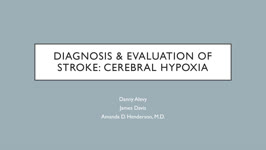Collection of materials relating to neuro-ophthalmology as part of the Neuro-Ophthalmology Virtual Education Library.
NOVEL: https://novel.utah.edu/
TO
1 - 25 of 4
| Title | Creator | Description | Subject | ||
|---|---|---|---|---|---|
| 1 |
 |
Diagnosis and Evaluation of Stroke: Cerebral Hypoxia | Danny Alevy; James Brian Davis; Amanda Dean Henderson | Neurons are particularly vulnerable to oxygen deprivation. Cerebral hypoxia can be caused by arterial thrombosis, embolism, hypoperfusion, cervical artery dissection, or cryptogenic causes. About 1/3 of ischemic strokes are from cryptogenic causes. Embolic strokes are the next most common (20-30%), ... | Atherosclerosis; Cerebral Hypoxia; Cervical Artery Dissection; Cryptogenic Ischemia; Embolism; Hypoperfusion; Ischemia; Stroke; Thrombosis |
| 2 |
 |
Large Vessel Occlusion | Justin Gibson, MD; Charles Prestigiacomo, MD | Example of a diagnostic cerebroangiogram performed on a patient undergoing a stroke. | Angiogram; Stroke |
| 3 |
 |
Supranuclear and Infranuclear Motility Disorder | Brittany Lin, MD; Rudrani Banik, MD | Power point of case presentation of patient with supranuclear left gaze preference from frontotemporal CVA (overcome by Doll's head), as well as right sixth nerve palsy with incomitant esotropia from pontine CVA. | Supranuclear Gaze Palsy; Sixth Nerve Palsy; Esotropia; Gaze Preference; Stroke |
| 4 |
 |
Central Retinal Artery Occlusion | Natasha Nayak, MD; Rudrani Banik, MD | Power point of case presentation of acute central retinal artery occlusion (CRAO) treated with tPA. Risk factors for stroke and results of EAGLE study reviewed. Imaging: Number of Figures and legend for each: 12 Slide 3: Figure 1: Table 1: Exam Findings Slide 3: Figure 2: Table 2: Exam Findings Cont... | Central Retinal Artery Occlusion; Stroke; Tissue Plasminogen Activator; EAGLE Study |
1 - 25 of 4
